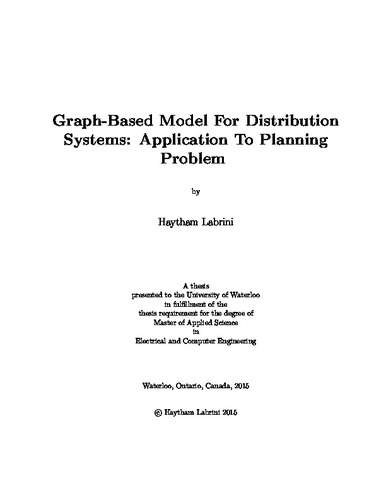| dc.contributor.author | Labrini, Haytham | |
| dc.date.accessioned | 2015-02-18 19:53:23 (GMT) | |
| dc.date.available | 2015-02-18 19:53:23 (GMT) | |
| dc.date.issued | 2015-02-18 | |
| dc.date.submitted | 2015-02-17 | |
| dc.identifier.uri | http://hdl.handle.net/10012/9182 | |
| dc.description.abstract | Distribution system engineers analyze distribution systems and operate them to minimize the costs of delivery of power while satisfying customers and imposed constraints such as voltage limits, congestion, system losses, substation/transformers operational loading limits, budget and such. It is hence a relatively complex and reasonably challenging task.
Researchers approached the problems that arise in the distribution system using different methods. The most accurate one to find the optimal solution for any problem is the extensive search (ES). This search evaluates each and every possibility and chooses the best option or options depending on the objective of the study. The only drawback of this method is the very large search space that makes it inefficient, especially for operational and on-line applications.
In order to decide on the feasibility of the solution, an evaluation function is chosen to discriminate between the different solutions. The power flow (PF) and optimal power flow (OPF) are the most widely used in literature; they describe the distribution system using the exact formulas, making them very accurate but time-expensive. PF and OPF are perfect for long term planning as there is no time constraints, and to some extent to operational planning. It is, however, very difficult to apply them to on-line/abnormal application such as restoration and reconfiguration as time is a critical component. A second problem is that most of these approaches do not take full advantage of the structure of the distribution system which changes with time.
This thesis proposes dynamic graph-based method as an approach and applies it to a distribution planning problem. The main objective is the cost of the upgrades of the different DG units and line reinforcement. The results show that taking account of the future changes in the system improves the benefits from the various installations. This approach has the potential to be extended to other problems distribution network may face. | en |
| dc.language.iso | en | en |
| dc.publisher | University of Waterloo | en |
| dc.title | Graph-Based Model For Distribution Systems: Application To Planning Problem | en |
| dc.type | Master Thesis | en |
| dc.pending | false | |
| dc.subject.program | Electrical and Computer Engineering | en |
| uws-etd.degree.department | Electrical and Computer Engineering | en |
| uws-etd.degree | Master of Applied Science | en |
| uws.typeOfResource | Text | en |
| uws.peerReviewStatus | Unreviewed | en |
| uws.scholarLevel | Graduate | en |

